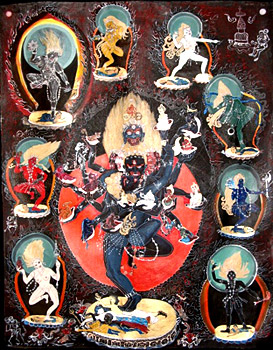The theories of Hevajra Tantra reveal the influence of the Mahayanic philosophical tradition inherent in the theories. A thematic analysis of the Hevajra tantra reveals the presence of certain insights which are specifically tantric in nature. Therefore, this gives credence to the view that tantric theory is a combination of the philosophical traditions of Mahayana Buddhism as well as certain tantric assumptions. The prime theoretical beliefs are discussed below.
Bi-polar Nature of the Non-dual Reality
 One of the most basic premises of the Hevajra Tantra is the in-built and inseparable bipolarity within the non-dual Absolute. The tantric vision of the Absolute is that it is a conjunctio oppositorum. The bi-polarity of the absolute is expressed as positive-negative, active-passive, male-female etc. In order to signify this polarity, the Hevajra tantra uses certain complex compound nouns such as prajna-upaya, sunyata-karuna, lalana-rasana, ali-kali etc. The name Hevajra itself signifies the inherent polarity of the non-dual absolute. Hevajra is Vajradhara. It has been asserted in the Yogaratnamala that Vajradhara is the Supreme Non-duality (vajradharabhattarakaw paramadaivatam). The name Hevajra has been explained in the text of the Hevajra tantra. It is said to be composed of two syllables, `he` signifying mahakaruna, and `vajra` meaning prajna. Karuna is also called upaya (kipopaya) and the polarity is also expressed as prajnopaya (wisdom and means). Prajna and upaya are associated with the two nadis lalana and rasana. Again, prajna and upaya are related to the vowel (ali) and consonant (kali). The text also employs other names like Candali and Vajrasattva, which imply the bi-polar nature of the Absolute. Thus the concept of the bi-polar nature of non-dual reality is extensively mentioned and elucidated throughout the text, and forms one of the basic theoretical assumptions of the Hevajra Tantra.
One of the most basic premises of the Hevajra Tantra is the in-built and inseparable bipolarity within the non-dual Absolute. The tantric vision of the Absolute is that it is a conjunctio oppositorum. The bi-polarity of the absolute is expressed as positive-negative, active-passive, male-female etc. In order to signify this polarity, the Hevajra tantra uses certain complex compound nouns such as prajna-upaya, sunyata-karuna, lalana-rasana, ali-kali etc. The name Hevajra itself signifies the inherent polarity of the non-dual absolute. Hevajra is Vajradhara. It has been asserted in the Yogaratnamala that Vajradhara is the Supreme Non-duality (vajradharabhattarakaw paramadaivatam). The name Hevajra has been explained in the text of the Hevajra tantra. It is said to be composed of two syllables, `he` signifying mahakaruna, and `vajra` meaning prajna. Karuna is also called upaya (kipopaya) and the polarity is also expressed as prajnopaya (wisdom and means). Prajna and upaya are associated with the two nadis lalana and rasana. Again, prajna and upaya are related to the vowel (ali) and consonant (kali). The text also employs other names like Candali and Vajrasattva, which imply the bi-polar nature of the Absolute. Thus the concept of the bi-polar nature of non-dual reality is extensively mentioned and elucidated throughout the text, and forms one of the basic theoretical assumptions of the Hevajra Tantra.
The Absolute as Union of Polarities
The Absolute is represented as the unity of polarities (yuganaddha) in the Vajrayana school of Buddhism. Iconographically, this is portrayed in the union of the Hevajra and Nairatyma. Sunyata is represented by the Nairatmya whereas Hevajra embodies karuna. Bodhichitta, according to the text, is the mingling of the sunyata and karuna. However there is no distinction in the Absolute. It is non-dual (advaya) and devoid of all constructive imagination (sarvasamkalpavarjita) and subject-object duality (grahya-grahaka varjita). There is no distinction in the absolute such as prajna-upaya or sunyata-karuna. It is characterised as Innate Joy (sahajanandam) or Great Bliss (mahasukha). This great bliss is inexpressible and has to be experienced within one`s own body (svasamivedyam mahat sukhairif). As said in the text, "By the complete awakening of the True Principle there is neither Wisdom nor Means."
The Body as the Sphere of Realisation
The theory about the body seen as the sphere of realisation brings about a certain difference between the Mahayana and Vajrayana tradition. Whereas the Mahayana tradition gives importance to the intellect and finally to Intuition in the realisation of the Absolute, Vajrayana highlights the role of the body within which alone the Absolute is experienced as bliss (dehabhave kutah saukhyam). It is stated in the text that truth resides within the body (dehastham ca mahajnanam). The process toward the realisation of the absolute as bliss involves several bodily practices (kaya sadhana). Both the entire gross body as well as subtle body constituted of nadis and chakras are involved in the practice of Vajrayana.
Body as the Microcosm
Vajrayanic beliefs hold the human body as the microcosm. Each and every aspect of the universe is identified with the various parts of the gross or subtle body. The elements that constitute the world are related to the four chakras. The five skandhas which form the universe are reduced to three, namely the Body, Speech and Mind and these are related to the three nadis lalana, rasana and avadhuti. The pithas are located within the body. The body is said to be the nikaya (assembly of bhikshus), and the womb is the monastery (vihdra). The three kayas of the Tathagata are located in the chakras of the subtle body. Thus, the body is conceived as a microcosm, which houses every aspect of the cosmos, the macrocosm.
Homologous Vision of Existence
Homologous means having a pattern or correspondence. From the point of view of the Vajrayana, all aspects of existence correspond with everything else. The entire text is seen involved in finding a series of such correspondences. Thus there are seen three-fold, four-fold, five-fold and sometimes six-fold `co-respondences`. Distinctions and divisions found in saitrvrti can be overcome by viewing everything as `co-responding`. The yogi is trained to see all things as related and finally to realise that all distinctions as well as relations are false.
Thus, stated are the various theoretical assumptions of Hevajra Tantra.









